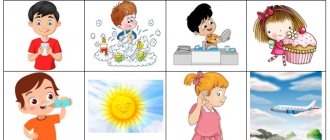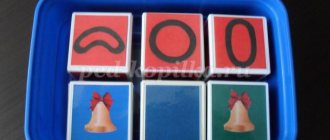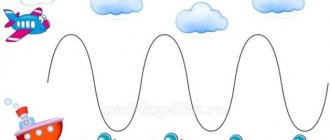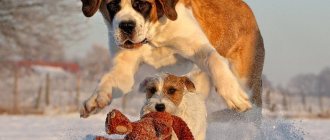Summary of a correctional speech therapy lesson on the topic: “Words denoting a feature of an object”
Author-compiler: Speech therapist Ashmarina Irina Nikolaevna
Goal: to form a concept of words denoting a feature of an object.
Tasks:
Educational:
- to develop in children the ability to coordinate an adjective with a noun;
-enrich vocabulary.
Educational:
- develop coherent speech;
-develop visual-spatial coordination.
Educational:
- cultivate perseverance and attention.
Material and technical equipment: pictures on the topic, notebooks, pens, pencils, task cards.
Progress of the lesson:
Emotional-setting moment (emotional inclusion)
The speech therapist asks students what date, day of the week, month it is.
Corrective stage
Articulation gymnastics (depending on what sound or letter we are going through during the lesson) “Smile”, “Delicious jam”, “Shovel”, “Horse”.
Activity stage.
The speech therapist asks questions to the students:
- What is the weather today? (Frosty)
- Why frosty? (we see light patterns on the windows)
—What day is it like when the sun is shining? (Solar.)
- And when there is no wind? (Windless.)
Speech therapist: Let’s find out what day it is today. (The day is frosty, sunny, windless.)
How can we say about the weather, does it have the same symptoms? (The weather is frosty, sunny, windless.)
Development of visual-spatial coordination.
Speech therapist: Guys, please draw a Christmas tree in the lower right corner of the sheet.
Let's select words-signs for it. What Christmas tree? (green, fluffy, small).
Speech therapist: Please draw a cloud in the upper left corner.
Match the words that match the cloud. What is it like? (white, soft, light).
Speech therapist: Draw a sun in the center of the sheet. What sun? (yellow, warm, bright, beautiful).
Fizminutka:
We repeat all the warm-up movements without hesitation! Hey! They jumped on the spot. Eh! We wave our hands together. Ehe - heh! They bent their backs and looked at the shoes. Hey - hey! Bent down lower. Bent closer to the floor. Turn around in place deftly. We need skill in this. What did you like, my friend? Tomorrow there will be another lesson!
Development of phonemic hearing and phonemic awareness
Speech therapist: Listen to a series of words and name from this series words that denote the attribute of an object: sun, earth, warm, spruce, green, yellow, soft, sky, high, snow, fluffy.
Enrichment of the grammatical structure of speech.
Read the words. Connect words with opposite meanings with lines.
Working with cards.
| Hardworking | Kind |
| wicked | silent |
| talkative | lazy |
| soft | brave |
| cowardly | hard |
Emotional-reflective stage (evaluative).
- Today we got acquainted with the words that mean? – What did you find most difficult in the lesson? — Rate yourself and your mood (emoticons)
Share on social media networks
To My World
0
Tweet
RќСЂР°РІРёС‚СЃСЏ
I advise you to read more on this topic
- Lexico-grammatical exercises and speech games on the topic “Clothing”
- Norms for child speech development at 3 years old
- Games for the development of memory and speech in preschoolers. Part 1. Game “Remember the pictures”
- Summary of a speech therapy lesson for children with special needs on the topic “Transport”
- Using fables as a means of developing coherent speech in older children
Frontal speech therapy lesson in 2nd grade on the topic “Word signs”
Target:
• Acquaintance with the adjective as a part of speech • Selection of objects to characteristics and vice versa; • Ability to coordinate nouns with adjectives; • Form adjectives from nouns; • Development of logical thinking, visual attention, perception, fine motor skills.
Equipment: models of fruits, berries, a poster with a picture of a glass jar, a grandmother, a poster for describing objects according to the diagram, cards with the name of the jam.
Progress of the lesson
I. Org. Moment
One student stands at the board, with his back to the other children, the speech therapist shows an object picture, and the children must name only words that answer the question WHAT? WHICH? WHICH? For example, juicy, round, heavy, sweet - what is it? Having guessed, the child turns to the children, they show him an object picture (this is how they guess three more words - orange, carrot). The topic of the lesson is formulated: today we will talk about words that tell us about objects, naming their shape, color, size, smell, etc. - these are words-signs.
Poem about an adjective: I define objects, With me they are very noticeable. I decorate your speech. You need to know me, take care of me.
II. Main part.
1. Game "Magic Bag". The bag contains mock-ups of fruits. Children take turns determining by touch what kind of fruit it is; after guessing or taking it out of the bag, the child describes this fruit: • Round, ruddy, sweet D.: apple
Next, write down the phrase round, ruddy, sweet apple in a notebook.
• Yellow, sour, oval D.: lemon Write down the phrase Yellow, sour, oval lemon in your notebook.
• Blue, sweet and sour, oval D.: plum Write down the phrase Blue, sweet and sour, oval pear in your notebook. L.: What words helped us guess and name the fruit? How can you call them in one word? (signs) What questions did the sign words answer? (WHAT? WHICH? WHAT?)
2. Riddles
There is a basket with fruits and berries on the table. Children will have to guess riddles and take the guessed fruit from the basket.
Black berries are a dark bush, they taste good. (currant)
It grew in the south into a bunch of fruits, and in the harsh winter it will come to our home with raisins (grapes)
Under the velvet peel He hid his juicy taste (peach)
Yellow, citrus fruit It grows in sunny countries, But it tastes sour And its name is………… (lemon)
Red beads hang from the bushes looking at us. Children, birds and bears (raspberries) love these beads.
What kind of fruit tastes good and looks like a light bulb, its green side is warmed by the sun, it turns yellow and red? (pear)
Having taken a fruit or berry from the basket, the children go to the board and talk about their plant according to the diagram: Poster with a diagram by which you can name the shape, size, color, taste, smell, and what the object feels like.
3. Formation of adjectives from nouns
Game “Making jam with grandma” On the board are cardboard mock-ups of jars, a mock-up of grandma. The jars have a picture of berries attached to them (strawberries, raspberries, currants, blueberries, viburnum, strawberries)
The children need to help their grandmother “sign” the name of the jam on the jars. To do this, you need to correctly answer the question WHAT? (from blueberries - WHAT?, etc.) Having named the adjective correctly, the child attaches the word to the jar. Having “signed” all the jars, everyone writes down a sentence with their own word (Grandma made strawberry jam. Grandma made viburnum jam. Etc.)
4. Folding strawberries from paper (simple origami for children)
III. Bottom line
- What words did you become familiar with? - What questions do adjective words answer? - What did you like? What was difficult?
Crossword:
She gnawed golden nuts in a fairy tale. Tree with a white trunk. In the animated film his name was Gena. Chicken chick. An urban small bird with grey-brown plumage. Color.
Crossword solve the words horizontally and read the resulting word vertically. Match the guessed adjective word with nouns. WHITE- (about what you can say “white”) – hare, snow, sugar... WHITE- ribbon, chamomile, board... WHITE- cloud, blanket, window...
Author of the material: Kochetova Natalya Mikhailovna
Also on topic:
Dictionary program
Topic: “Words-signs”
Topic: Words denoting the attribute of an object.
Objectives: 1. To consolidate ideas about words denoting an object and the action of an object.
Introduce words denoting a feature of an object (which
questions are answered, their graphic representation). Learn to ask questions
words-signs, find them using questions. Improve skills
word formation. Enrich your vocabulary.
2.Develop articulatory, general, fine motor skills. Improve
mental processes: perception, attention, memory, thinking.
3. Nurture the moral and spiritual qualities of the individual through the ability to listen
interlocutor, work in cooperation (in pairs); ability to analyze
life situation, highlighting the moral side in the actions of the heroes.
Progress : I. Speech warm-up
- The one who repeats after me without errors the expression will sit down:
*Our guest took away our cane. * The crab made a rake for the crab. * There are pins on the counter, and needles on the shelf. *Thirty-three cars in a row, chattering, chattering.
*The Christmas tree has pinned needles.
II. Organizing time
Game "Tops and Roots"
(development of interhemispheric interactions of the brain)
- In some vegetables we eat what grows on the surface of the earth (tops), and in others - what is in the ground (roots).
- Raise your right hand, if the named vegetable contains the “top” for food; if the “root”, then your left hand:
cabbage, turnip, tomato, cucumber, potato, apple, pepper, zucchini, radish, carrot, banana, eggplant
III. Repetition of covered material
- Name any word that denotes an object. What question does it answer?
- Match your word with an action that this object can perform.
- Put a question from the word-object to the word action and vice versa.
IV. Main part
1. Familiarization with words denoting the characteristics of objects (game “Wonderful Bag”) - the student takes out the object apple.
-What do you have in your hands?
- Tell me, what color is it? size? taste? (the teacher puts words on the board)
-To the object - an apple,
we have selected words that represent the words of this subject.
-What did these words help us learn? (what kind of subject).
by analogy : pear, lemon
-What question did I ask you to find out about apple, pear, lemon?
(questions are put on the board).
-Today, we will work with words denoting the characteristics of objects.
2. Exercise “Choose words” (individual work)
-On your tables there are pictures of objects, with words-attributes of objects and questions for the words-attributes. You need to match your pictures with a question and attribute words that are appropriate to this subject. (examination)
Lesson notes
Topic:
“Words denoting the actions of objects”
Purpose:
consolidation of the concept of “words - actions”.
Differentiation of the grammatical form of singular and plural action words. Objectives:
1. Educational - clarify knowledge about words and actions; - develop the ability to use grammatical forms (singular and plural) in speech. 2. Corrective - developmental - develop voluntary attention; - develop auditory memory; — develop fine motor skills of the hands; - develop thinking (operations of analysis, relationship with a model and generalization) 3. Educational
- develop interest in the activity,
- cultivate observation of linguistic phenomena, speech activity
— cultivate accuracy when writing in notebooks, independence when completing tasks.
Progress of the lesson
1.Org. moment
We welcome guests -
Our school teachers
You sit down very quietly
And don’t be lazy to work.
Be diligent in class, be calm and attentive. Speak clearly, clearly so that everyone can understand.
2. Psychological attitude to work.
— In every lesson you learn something new. Every day you learn more and more. I wish you to learn new and interesting things in this lesson.
-What will you be like in class? Repeat after me
Autotraining
I'll be careful.
I'll remember everything.
I want to learn new things.
I'm ready! I'm ready!
- Updating knowledge.
— How can we describe everything that surrounds us in one word?
- What questions do words-objects answer?
- The question of who is answered by living words - objects. To the question what? - inanimate words, objects. Do we underline words and objects in sentences? (one line).
— You have cards with symbols on your tables. I will show pictures, if the objects are alive, then a card with the question who? What if they are not alive?
4.Introduction to the topic
— Guys, what do you do in speech therapy classes? (We... write, read, speak)... (various answer options). “And today we will learn to pronounce words correctly and clearly, answer questions with complete answers, and tell stories.”
Guys, what day and month is it today? Season? (day, month, season).
5. Report the topic of the lesson.
Today I came to your lesson not empty-handed, but prepared a surprise. She brought a beautiful briefcase. Let's see what's in it. (The speech therapist asks each child to take an object out of the briefcase. The briefcase contains: pencils, scissors, and pen). Tanya, get the object. What do you have? (I have a pencil). Vagan, get the object. What do you have? (I have scissors). Sasha, get the item. What do you have? (I have a pen). And Ilyusha and Alyosha will answer questions. Tanya, what will you do with a pencil? (I will draw). Draw the sun. Ilyusha, what is Tanya doing? (Draws). Vagan, what are you going to do with the scissors? (I will cut). Cut the leaf. Ilyusha, what is Vagan doing? (Cuts). Sasha, what are you going to do with your pen? (I will write). Write your name. Alyosha, what is Sasha doing? (Writes0. Who was attentive? What question did I ask? (What does it do?) (Demonstration of a card with the question - “what does it do?”)
What are our guests doing? (Guests sit, watch, listen, record).
Right. Now look at the picture. (Demonstration of a picture showing students sitting and listening) - What are the students doing? (Students sit, watch, listen). The question I asked was “what are they doing?” (Demonstration of a card with the question “what are they doing?”). — How many interesting words you just named: writes, draws, cuts, sits, listens. These are all words of action. What questions do action words answer? (Draw the children’s attention to the board on which cards with questions hang:
(“What is he doing?”, “What are they doing?”). The topic of our lesson is words - actions. - Let's read it in chorus. (Children: read the title of the topic). These are very important words. Without them, we cannot tell stories, answer questions, solve riddles. Guess my riddle: There is a big and bright house. Why are there a lot of people in it? And they write and count, They create, they dream about the future. What is this? ( This is a school). What do students do at our school? (At school they write, count, decide).
6. Work on the use of words - actions that answer the question “what does it do?”, “What do they do?”
Let's look into the windows of our school and see what the kids are doing?
What is the girl doing? (The girl sings). Name the word - action. (Sings). What question does this word answer? (The word answers the question “What does it do”?) Is the action performed by one person or many? ( One man). (Under the sign with the question “what is he doing?” The word “singing” is posted) What are the children doing? (Children sing). Find the word - action. (Singing). What question does the word “sing” answer? (The word answers the question “What are they doing?”) Is the action performed by one person or many? (Many people). (Under the sign with the question - “What are they doing?” - the word “singing”) Listen to me carefully: - “What is he doing? - Singing.” “What are they doing? “They sing.” You heard that our questions are different. If an action is performed by one person, we ask the question “What is he doing?”; if the action is performed by many people, we ask the question “What are they doing?” (Draw the children’s attention to the cards on the board for visual fixation). What is the girl doing? (The girl writes). Where is the word - action? (Writes).
(The card is given to the student with the word “writes”). - What question does the word action answer? (To the question “What does it do?”) Attach the card to the correct column. (The child attaches the card to the board.) What are the children doing? (Children write). What word is action? (They write0. (The card is offered to the child with the word “write”). What question does the action word answer/ (The action word answers the question “what are they doing?”) Place the card with the word in the correct column.
What is the girl doing? (The girl is dancing.)
Where is the word - action? (Dances). What question does the action word answer? (The action word answers the question “what does it do?” Place the card with the word in the correct column. What are the children doing? (Children are dancing). Where is the action word? (Dancing). What question does the action word answer? (Action word answers the question “what are they doing?”) How many interesting things do the kids do at school. - Read the words in the first column. (Sings, writes, dances) What question do these words answer? (These words answer the question: “What does he do?”) Read the words in the second column? (They sing, write, dance). What question do these words answer? (These words answer the question: “What are they doing?”) Remember guys - If an action is performed by one person (or object), we ask a question - what does it do? And if an action is performed by several people (or objects), then we ask - what are they doing? Do you remember? Let’s repeat: if the action is performed by one person (or object), we ask the question - “What is it doing?” If the action is performed by several person (or objects), then we ask - “What are they doing?” We underline words - actions with two features. Open your notebooks and write down the words in two columns. In the first column are words that answer the question - what does it do? In the second column - what are they doing? Underline the action words with two strokes. Well done guys, close your notebooks.
7. Phys. just a minute. Speech therapist: - The guys at our school dance and sing, let’s do it too
Let's perform the movements. All the guys stood up together and walked in place. They stretched on their toes and turned to each other. We sat down like springs, and then we all sat down quietly.
We're on vacation soon. We must rest well and gain strength. It's best to relax in nature. Let's go to the forest with you. What time of year is it now? (Spring) We will go with you to the spring forest. In spring, migratory birds fly to us from the south. The forest comes to life and is filled with bird voices. Let's listen and guess whose voices are heard.
(The voice of a cuckoo, the voice of a crow, the voice of a sparrow, the hooting of an owl, the knocking of a woodpecker)
The cuckoo (what is it doing?) cuckoos. The crow (what is it doing?) croaks. The sparrow (what is he doing?) tweets. The owl (what is it doing?) hoots. The woodpecker (what is he doing?) knocks. Birds (what are they doing?) pecking, flying, hovering.
Take the cards. Write down and underline the action words.
8. Gymnastics for the eyes.
9. Compiling an oral story using words - actions. Look at the forest clearing. Who lives in a forest clearing? (Birds, hares, woodpeckers, hedgehogs) What grows in the clearing? (Trees, bushes, lilies of the valley). Let's make up a story about our forest clearing. There are proposals on your tables. Each piece of paper has a number on it. We will collect the text from the sentences in order. And instead of dots, you must choose action words, choose the appropriate one from the brackets0 I'm starting. My first suggestion. Spring came. Who has the second proposal?
2 In the forest ... (sing) birds.
Sentence 3: Woodpeckers loudly ... (knock) on the trunk.
Sentence 4: Here under the bush...(jumps) a hare.
Sentence 5: In the grass...(rustling) hedgehogs.
Sentence 6: Under the tree...(blooms) a lily of the valley.
Well done. It's time for us to go back to school.
9. Summary of the lesson. Performance evaluation. Our lesson is coming to an end. Remember what words we talked about in today's lesson. (We talked about words and actions). What questions do action words answer? (Action words answer the questions “What does it do?” “What do they do?”) That’s right, guys! How do we emphasize action words? (Two features). You worked well in class today: you were attentive, listened, and answered questions correctly. It was a pleasure to work with you. Our lesson is over.
Use of sign words
The main features that characterize adjectives:
- size: small dog;
- color: white snow;
- shape: round chair;
- material: wool sweater;
- accessories: cat food;
- temperature: hot tea.
Adjectives make our speech more beautiful, clearer, and more varied. Any explanation will become clearer if you describe the signs. Imagine, a friend says simply: a game, - you demand to clarify which one: computer, sports, new, boring. Although you know very well what a game is, without signs it can be difficult to understand each other.
In terms of the number of uses in speech, adjectives occupy third place, after nouns and verbs. In any situation, our brain strives not just to name an object, but to evaluate it and describe its qualities.
Summary of a literacy lesson in the preparatory group “Words are signs of objects”
Lyudmila Baeva
Summary of a literacy lesson in the preparatory group “Words are signs of objects”
Purpose: to give the concept of words - names of characteristics of an object ;
grammatical questions to them ; develop vocabulary ;
*develop the ability to hear and listen to spoken words ;
*develop independence, friendliness, mutual assistance, and the ability to play in a team.
Equipment: subject pictures in envelopes, toys, 2 books with pictures of a sparrow, surprise box .
Progress of the lesson : Well, everyone - stood in a circle, everyone suddenly held hands, we will stand next to each other - answer questions. Let's start studying, we will try, Repeat, don't yawn, remember everything.
Game "Be careful"
- Guys, let's check if we are attentive? And some words will help us do this. Game conditions : You only need to clap on the action word :
Table, good, wash, watch, round, melt, revenge, try, dog, cat, jump, fluffy, sit. - What great fellows you are! Do you know how to play in a team?
Game “Imagine and Show”
Listen to the rules of the game : you need to split into 2 teams. The first team must come up with something and show it, the second team names the given object and its action . Word-object and word-action . For example: The plane is flying.
A story with elements of conversation.
-I have two books in my hands. I will read you two stories. Listen and tell me which story you like best and why.
Once upon a time there was a sparrow. It has paws, a head, a beak, and eyes.
Once upon a time there lived a small, agile sparrow. He has tiny paws, a round head, a sharp, short, black beak, and smart little black eyes.
-Which story did you like best?
— Why was the 2nd story more interesting?
-What are the words that helped make the story more interesting?
-Today we will get acquainted with new words that helped describe the sparrow. We will learn what these words and what questions they answer.
- What sparrow? Small, mobile. These words are called feature words .
- Why do we still need words-signs ? (to talk about the color, shape, size of the described object )
- Now let’s try to guess the object and give it a description with words-attributes .
Game "Guess the object ?"
In a closed box with cut-out side windows for hands, there are items . identifies this object by touch , names it, then takes it out and passes it around. Everyone must give one definition to this subject .
For example: the car is metal, red, heavy, clean, beautiful, etc.
- What questions do these words ? (What kind of car)
- What are these words ? ( sign words )
-Guys, there is another interesting game, also called “Guess the Object ”
.
I will name the characteristics of the object , and you can guess what or who I am talking about.
Who is this? Or what is it?
Big, brown, club-footed, shaggy (bear)
.
Long-eared, cowardly, fast (hare)
.
- Now try to make a riddle about an object , using only the words signs of the object , and the pictures that are on the table in the envelope will help you. Just don’t show this picture to anyone until the guys guess your riddle.
-Guys, another game awaits us : “Say the opposite”
. The game will be with a ball.
I will name the sign word , and you name the word with the opposite meaning.
For example: cheerful - sad.
Soft. High. ; Kind. ; Fast. ; Long. ; Hot. ; Silly. ; Brave. ; Dark. ; Smart. ; Bald. ; Young. ; Heavy. ; Wet.
Lesson summary
- What words did we learn today?
- What questions are answered by words-attributes of objects ?
- Well done. Thanks to all.






